GP77
| Location: Bushy Park | |
| Aust. Soil Class.: Bleached, Eutrophic, Brown SODOSOL | General Landscape Description: Level plain (above present floodplain). |
| Geology: mid-late Pleistocene | Mapping Unit: Briagalong |
Soil Profile Morphology:
Surface Soil
| A1 | 0-10 cm | Dark brown (10YR3/3); fine sandy loam; weak coarse blocky structure; very firm consistence dry; pH 5.3; clear change to: | 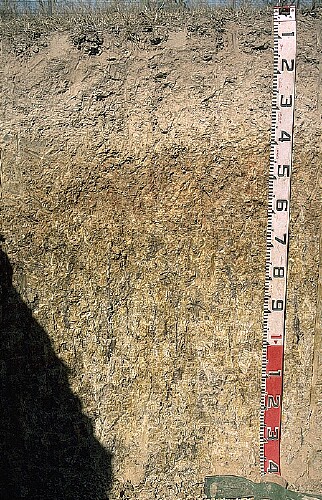 GP77 Profile |
| A2 | 10-40 cm | Brown (10YR5/3), conspicuously bleached (10YR7/2d); fine sandy loam; weak coarse blocky structure; very firm consistence dry; contains a few (2%) ferromanganiferous nodules (2-5 mm in size); pH 5.5; sharp change to: | |
| Subsoil | |||
| B21 | 40-70 cm | Yellowish brown (10YR5/4) with strong brown (7.5YR5/6) and yellowish brown (10YR5/6) mottles; light medium clay; moderate coarse prismatic, parting to strong coarse blocky structure; strong consistence dry; pH 7.3: | |
| B22 | 70-100 cm | Light brownish grey (10YR6/2) with brownish yellow (10YR6/8) mottles; medium clay; strong coarse prismatic, parting to strong coarse blocky structure; strong consistence dry; contains a few (2%) quartz fragments (2-5 mm in size); pH 7.6: | |
| B23 | 100+ cm | Light brownish grey (10YR6/2) with yellowish brown (10YR5/8) mottles; medium clay; strong consistence dry; pH 7.7. | |
Key Profile Features:
- Strong texture contrast between surface (A) horizons and subsoil (B21) horizon.
- Conspicuously bleached subsurface (A2) horizon.
pH | Salinity Rating | |||
Surface (A1 horizon) | Strongly Acid | Moderate | Non-Sodic | None1 |
Subsoil (B21 horizon) | Slightly Alkaline | Very Low | Non-Sodic | Moderate2 |
Deeper subsoil (at 1 m) | Slightly Alkaline | Very Low | Sodic | Complete |
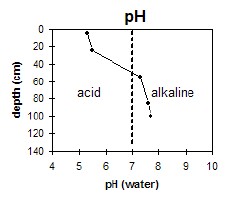 The surface is strongly acid. The subsoil is slightly alkaline throughout. | 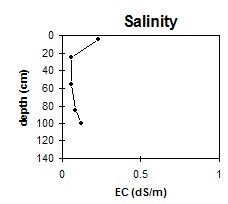 The surface salinity rating is moderate. The subsoil is very low. | 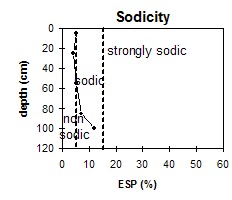 The surface and upper subsoil is non-sodic. The lower subsoil is sodic at 70 cm depth. | 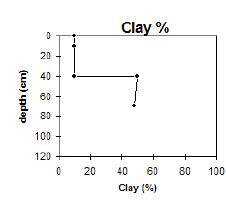 The clay content increases sharply at 40 cm depth. |
Surface (A) Horizons
- The surface soil is strongly acid. This indicates that aluminium and manganese toxicity may occur. The level of exchangeable aluminium measured for this pit site is, however, quite low (<10 mg/kg) and unlikely to restrict the growth of aluminium sensitive species. A pH/aluminium test is, however, best performed from samples taken across the paddock and bulked together. Other factors also need to be considered before lime is recommended (eg. pasture species grown, method of application, local trial responses, soil surface structure and likely cost/benefit).
- Manganese toxicity may also occur particularly in poorly drained situations (as waterlogging may bring manganese into solution).
- Deficiencies of molybdenum and phosphorus may occur in strongly acid surface soils. Increasing soil pH by lime application should enable phosphorus (from superphosphate) and molybdenum to become more available. If lime is required, and pH is increased, then the availability of major nutrients should improve.
- The surface soil has a high fine sand and silt content (71%).
- The surface (A1) horizon is non-sodic but disperses moderately after remoulding. This indicates that tillage or over-stocking of the soil whilst in a moist to wet condition may result in structural degradation (e.g. surface sealing, increased cloddiness) occurring. Raindrop action on bare soil may have a similar effect, so it is important to maintain surface cover.
- The level of soluble salts in the surface is moderate and may restrict the growth of salt sensitive species.
- The inherent fertility of the surface (A1) horizon (based on the sum of the exchangeable calcium, magnesium and potassium cations) is low. Planting legumes may help to alleviate this. The moderate levels of organic matter at this site are important for improving soil fertility, water holding capacity and enhancing surface soil structure; especially with the high fine sand content of the surface soil (46%). Nitrogen levels are also high reflecting the high organic matter levels.
- The low wilting point value (i.e. 6.9%) of the surface (A1) horizon indicates that plants will be able to utilise very light rains when the soil is dry. However, due to the low water storage capacity, plants will soon suffer moisture stress unless further rain falls occur.
- The presence of bleaching in the subsurface (A2) horizon indicates that periodic waterlogging occurs above the more slowly permeable subsoil. This horizon also has a low inherent fertility.
- The presence of mottling in the subsoil indicates that the profile is seasonally waterlogged.
- The subsoil has a moderate inherent fertility (based on the sum of the exchangeable basic cations).
- The coarsely structured upper (B21) subsoil disperses completely in water. This indicates that root and water movement will be significanlty restricted through the subsoil.


